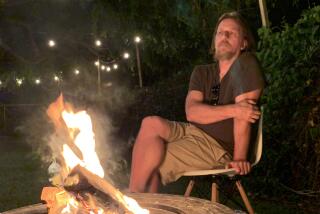Lost in the neon wilderness
CHICAGO — The Steppenwolf Theatre feels like a womb. It’s warm, dark, soporific, full of voices barely loud enough to be distinguished, a setting beyond time. Outside, the streets of Old Town are laced with spring afternoon snowflakes; on the South Side, at U.S. Cellular Field (formerly Comiskey Park), opening day has been postponed.
The fact that Comiskey is no longer called Comiskey is a sign of how Chicago has changed, and not for the better. But then, the old Comiskey had a date with the wrecking ball almost two decades ago. The new park -- bland, lifeless, another corporate sellout -- is the kind of ersatz place marketers and con men try to pass off as authentic in a world that no longer remembers what authentic means.
“We grew out of the beer-cork stage into lagging for ten-for-a-penny pictures of baseball players,” Nelson Algren wrote about the real White Sox in “A Lot You Got to Holler,” a story from his 1947 breakthrough book, “The Neon Wilderness.” “Like the beer corks, some of these had a larger value than others: I remember trading an entire strip of ten to get just one of Joe Jackson. And a month later, when Jackson had been kicked out of organized baseball, I had to give one of him, one of Buck Weaver, and two Happy Felsches just to get one Ray Schalk -- who’d been on the original strip I’d traded for Shoeless Joe in the first place.”
Algren would have turned 100 this year, and it’s an open question as to whether he would have recognized this new Chicago, although the city seems intent on recognizing him. His face -- skeptical, wary, framed by a red hunting cap and the upturned collar of an overcoat -- peers out from the cover of the Chicago Reader, teasing to a previously unpublished piece of fiction called “Entrapment,” taken from “Entrapment and Other Writings” (Seven Stories: 304 pp., $19.95 paper), a new book edited by Brooke Horvath and Dan Simon to mark Algren’s centennial. En route to Steppenwolf, a cabbie offers a detour past Algren’s old digs on Wabansia Avenue, in a working-class neighborhood turned hipster hangout, where the factories have been resurrected as lofts.
--
Fans in high places
Then, there’s the action at the theater. Arranged in a line across the stage are nine chairs, in which sits an unlikely array of people, beginning with Simon and “Wild at Heart” author Barry Gifford, and featuring novelists Russell Banks and Don DeLillo and actor Willem Dafoe. Together, they’re rehearsing a bit of reader’s theater called “Nelson Algren Live,” which will be performed this night before a packed house, including Harold Augenbraum, executive director of the National Book Foundation, and former Life magazine photographer Art Shay, who took the most iconic shots of the author, black-and-whites of him playing poker or peering through barroom windows, pictures so gritty you can almost feel the dirt rise off the frame.
These photos, as much as anything, are responsible for Algren’s image as “the poet of the Chicago slums,” yet they also cast him in amber: a midcentury figure, smoking a cigar, eyebrows raised behind round glasses, turning over another card. Sixty years after winning the first National Book Award, for his 1949 novel of addiction, “The Man With the Golden Arm,” Algren has become vestigial enough that discussions of a national celebration were scaled back after, as Augenbraum notes in an e-mail, “we concluded that though his writing continued to resonate, the number of his readers and his currency among the general reading public had diminished.”
So what, exactly, is Algren’s legacy? That’s the question the Steppenwolf event means to raise. The show is built around a series of interviews he gave in the early 1960s to a writer named H.E.F. Donohue (later published as “Conversations With Nelson Algren”). The one-night-only affair seems appropriate, given Algren’s state of cultural eclipse. Perhaps the most telling anecdote comes by way of the late Studs Terkel, the author’s lifelong friend, who recalls going to see Billie Holiday with Algren in 1956, when Lady Day was getting near the end.
In Terkel’s words: “Billie’s voice was shot, though the gardenia in her hair was as fresh as usual. Ben Webster, for so long a big man on tenor, was backing her. He was having it rough, too. Yet they transcended. There were perhaps fifteen, twenty patrons in the house. At most. Awful sad. Still, when Lady sang ‘Fine and Mellow,’ you felt that way. And when she went into ‘Willow, Weep for Me,’ you wept. Something was still there, that something that distinguished an artist from a performer: the revealing of self. Here I be. Not for long, but here I be. In sensing her mortality, we sensed our own.”
--
An incredible run
That something that distinguished an artist from a performer: This is also at the heart of Algren’s writing, or at least the five books he produced between 1942 and 1956, which remain among the most serious and moving in American literature. Beginning with “Never Come Morning,” the story of a Polish hoodlum and boxer in Chicago, and ending with his New Orleans romp “A Walk on the Wild Side,” it’s as good a run as has ever been put together by any writer anywhere.
With these books, Algren defined postwar American urban fiction, interweaving threads of social realism, his own leftist politics and noir. Still, what drives his work is always character, the challenges and degradations of daily living, of trying to make one’s way in a world that doesn’t care.
In “The Captain Has Bad Dreams,” the story that opens “The Neon Wilderness,” Algren describes a cop haunted by the men in the evening’s lineup. “In sleep,” he writes, “he saw their pale lascivious faces; watched them moving like blind men beneath the thousand-columned El, where a calamitous yellow light filtered downward all night long. In this tragic and fluorescent dream they passed and repassed him restlessly, their faces half averted, forever smiling uneasily as though sharing some secret and comforting knowledge of evil which he could never know.”
In “The Man With the Golden Arm,” he remembers “the luckless living soon to become the luckless dead. The ones who were fished out of river or lake, found crumpled under crumpled papers in the parks, picked up in the horse-and-wagon alleys or slugged, for half a bottle of homemade wine, in the rutted tunnels that run between the advertising agencies and the banks.” Here we have the people who populate Algren’s fiction, and much of it -- especially the short stories -- is written in their language, as if in giving voice to the voiceless, Algren has uncovered the true purpose of literary art.
These are the voices that ring out at the Steppenwolf, the voices of Frankie Machine and Sparrow Saltskin, of Rose, the narrator of “Please Don’t Talk About Me When I’m Gone,” who seduces an innocent into drugs to get at his money, only to end up feeling “that I was wadin’ in a lake late at night up to my chin ‘n the water gettin’ deeper all the time ‘n tryin’ to push me off my feet, ‘n not knowin’ where the shore was any more in the dark.” And then there’s Blackie, the drunken boxer of “The Lightless Room” -- a 1939 story, published for the first time in “Entrapment” -- that Dafoe animates with a perfect Irish brogue.
“He revealed in his writing a kind of isolation, loneliness and sadness that he had a hard time revealing in his life,” Banks explains in the theater’s ramshackle green room between the rehearsal and the performance. DeLillo agrees. “I used to think of him alone,” he says. “He had friends, but he was not attached. I used to wonder what that was like.”
As they talk, Gifford and Simon drift over, and soon they’re all back-and-forthing about their favorite Algren books. DeLillo picks “Never Come Morning”; Banks prefers “The Neon Wilderness,” calling it “a perfect book.” Gifford splits the difference and opts for both, while Simon chooses “The Man With the Golden Arm.” Someone brings up “Chicago: City on the Make,” the 1951 “prose poem” that made Algren persona non grata in his own town. “How many writers are there,” Banks asks, “about whom we could sit around and argue what’s their best book? With him, you have four or five.”
--
A long falling out
All this raises the question: Why hasn’t Algren lingered more? Partly, Banks suggests that it has to do with the bifurcation at the heart of his work: “The people he wrote about,” he says, “were different than those who read his books, which is a divide that’s impossible to get around.”
But not unlike Lady Day, Algren flamed out, falling prey to alcohol and bitterness. He left Chicago first for Paterson, N.J., where he moved to write about Rubin “Hurricane” Carter, the boxer unjustly convicted of triple murder, and then for Long Island, where he died in 1981 at age 72. He sold “The Man With the Golden Arm” to Otto Preminger but hated the 1955 movie, reportedly grumbling that “Sinatra shook heroin like he shook a summer cold.” Algren alienated everyone, complaining that he hadn’t gotten what he deserved and then didn’t write a book worth reading for the last 25 years of his life. “Some fighters can only go eight,” Gifford says, “and he got tired, like Kerouac got tired.” And yet, he continues, “He wrote enough.”
Gifford’s correct, of course, although it’s not just a matter of what he wrote, but how. He stood up for what was important, and for what was right. “ ‘What is literature?’ Jean-Paul Sartre once asked in a small volume bearing that title,” Algren declared, invoking his rival for Simone de Beauvoir’s affections, in a 1961 afterword to “Chicago: City on the Make.”
“I submit that literature is made upon any occasion that a challenge is put to the legal apparatus by conscience in touch with humanity.
“Now we all know.”
--
More to Read
Sign up for our Book Club newsletter
Get the latest news, events and more from the Los Angeles Times Book Club, and help us get L.A. reading and talking.
You may occasionally receive promotional content from the Los Angeles Times.









